
James Marcellus Arthur "Sunny" Murray was an American musician, and was one of the pioneers of the free jazz style of drumming.

Marion Brown was an American jazz alto saxophonist, composer, writer, visual artist, and ethnomusicologist. He was a member of the avant-garde jazz scene in New York City during the 1960s, playing alongside musicians such as John Coltrane, Archie Shepp, and John Tchicai. He performed on Coltrane's landmark 1965 album Ascension. AllMusic reviewer Scott Yanow described him as "one of the brightest and most lyrical voices of the 1960s avant-garde."

The John Coltrane Quartet Plays is an album by jazz musician John Coltrane, recorded in February and May 1965, shortly after the release of A Love Supreme.
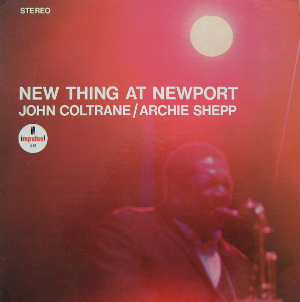
New Thing at Newport is a 1965 live album featuring two separate sets from that year's Newport Jazz Festival by tenor saxophonists John Coltrane and Archie Shepp. It was recorded four days after the recording session for Coltrane's album Ascension, on which Shepp appeared, and is one of several albums documenting the end stages of Coltrane's "classic quartet," which would begin to break up by the end of that year with the departure of McCoy Tyner.
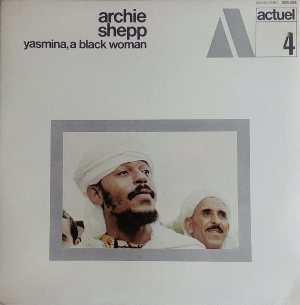
Yasmina, a Black Woman is a jazz album by Archie Shepp, recorded in 1969 in Paris for BYG Actuel. It features musicians from the Art Ensemble of Chicago. The first track, giving its title to the album, is a long free jazz piece by an 11-piece orchestra; in it, the references to Africa that Shepp had experimented with only a few weeks earlier in Algiers are to be found in the use of African percussion instruments, or the African incantations sung by Shepp himself at the beginning of the track. The other two pieces, a homage to Sonny Rollins written by trombonist Grachan Moncur III and a standard, played by a more traditional quintet and quartet respectively, are more reminiscent of the hard bop genre, although the fiery playing of the musicians, notably Shepp himself, gives them a definite avant-garde edge. It was originally issued on CD by Affinity, mastered from an incredibly noisy vinyl source and later reissued by Charly from the original master tapes.

Poem for Malcolm is a jazz album by Archie Shepp. Recorded in Paris in August 1969 only two days after Yasmina, a Black Woman, it again features musicians from the Art Ensemble of Chicago. This time, the tone is resolutely set to avant garde and free jazz, with a political edge in the all but explicit tribute to Malcolm X. The Allmusic review by Scott Yanow states: "This LP from the English Affinity LP is a mixed bag. Best is 'Rain Forrest' on which tenor saxophonist Archie Shepp, in a collaboration with trombonist Grachan Moncur III, pianist Vince Benedetti, bassist Malachi Favors, and drummer Philly Joe Jones, perform some stirring free jazz; the interplay between Shepp and Jones is particularly exciting. On a four-and-a-half minute 'Oleo,' Shepp "battles" some bebop with fellow tenor Hank Mobley, but the other two tracks, a workout for the leader's erratic soprano on 'Mamarose,' and his emotional recitation on 'Poem for Malcolm,' are much less interesting, making this a less than essential release despite 'Rain Forrest'." It was originally issued on CD by Affinity mastered from a vinyl source and later reissued by Charly from the original master tapes.
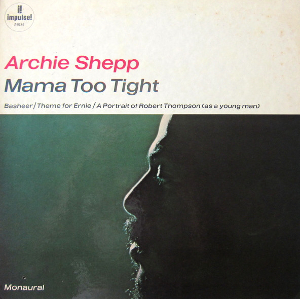
Mama Too Tight is an album by Archie Shepp released on Impulse! Records in 1967. The album contains tracks recorded by Shepp, trumpeter Tommy Turrentine, trombonists Grachan Moncur III and Roswell Rudd, tuba player Howard Johnson, clarinetist Perry Robinson, bassist Charlie Haden and drummer Beaver Harris in August of 1966.
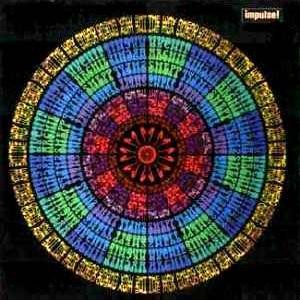
The Way Ahead is an album by Archie Shepp, released on Impulse! Records in 1968. The album contains tracks recorded by Shepp, trumpeter Jimmy Owens, trombonist Grachan Moncur III, pianist Walter Davis Jr., bassist Ron Carter and drummers Roy Haynes and Beaver Harris in January 1968 with two additional tracks featuring baritone saxophonist Charles Davis, pianist Dave Burrell and bassist Walter Booker recorded in February 1969, and first released on Kwanza (1974), added to the CD release.

Kwanza is an album by Archie Shepp released on Impulse! in 1974. The album contains tracks recorded from September 1968 to August 1969 by Shepp with four different ensembles.
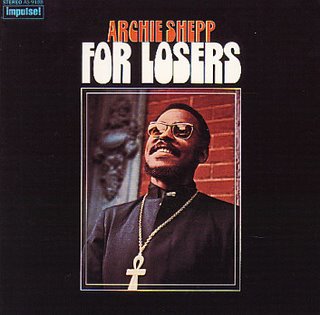
For Losers is an album by Archie Shepp released on Impulse! in 1970. The album contains tracks recorded from September 1968 to August 1969 by Shepp with three different ensembles. The AllMusic review by Rob Ferrier states "for anyone wishing to understand the music and career of this brilliant musician, this is an undervalued piece of the puzzle".
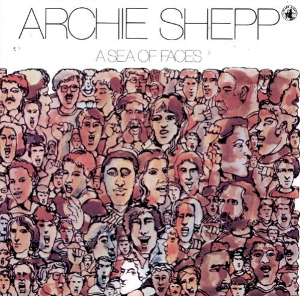
A Sea of Faces is an album by avant-garde jazz saxophonist Archie Shepp recorded in Milan, Italy, on August 4 and 5, 1975, and released on the Italian Black Saint label. It features performances by Shepp with Charles Greenlee, Dave Burrell, Cameron Brown, Beaver Harris, Rafi Taha and Bunny Foy.

Bill Dixon 7-tette/Archie Shepp and the New York Contemporary 5 is an album released on the Savoy label originally featuring one LP side by Bill Dixon's septet and one LP side by the New York Contemporary Five featuring saxophonist Archie Shepp. The album resulted from Dixon and Shepp's contractual obligations to provide Savoy Records with a second album after the Archie Shepp - Bill Dixon Quartet (1962) but following a professional separation.

Destination... Out! is an album by American saxophonist Jackie McLean recorded in 1963 and released on the Blue Note label. It is the second McLean album to feature Bobby Hutcherson on vibraphone and Grachan Moncur III on trombone. The rhythm section is completed by bassist Larry Ridley and drummer Roy Haynes.

Evolution is the debut album led by the American trombonist Grachan Moncur III, recorded in 1963 and released on the Blue Note label. Featuring alto saxophonist Jackie McLean, trumpeter Lee Morgan, vibraphonist Bobby Hutcherson, bassist Bob Cranshaw and drummer Tony Williams, Evolution is considered a significant contribution to the jazz avant-garde. Two McLean albums also recorded for Blue Note in 1963 featured Moncur and his compositions, and explored the same "inside/outside" musical approach.
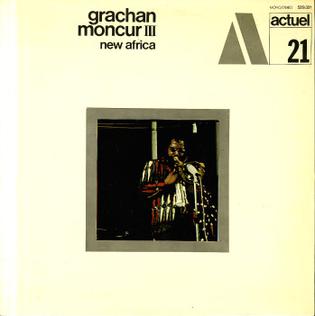
New Africa is an album by American trombonist Grachan Moncur III recorded in 1969 and released on the BYG Actuel label in the same year. It features alto saxophonist Roscoe Mitchell, pianist Dave Burrell, bassist Alan Silva and drummer Andrew Cyrille. Tenor saxophonist Archie Shepp performs on the final track.

Sonny's Time Now is an album by American free jazz drummer Sunny Murray, his first as a leader. It was recorded in New York City on November 17, 1965 and first released on LeRoi Jones' Jihad label. It was later reissued on the DIW and Skokiaan labels.

Luna Surface is an album by multi-instrumentalist Alan Silva, recorded on August 17, 1969 and released later that year on the BYG label as part of their Actuel series. His first recording as leader, it features Silva on violin along with a large ensemble known as the Celestrial Communication Orchestra.

Homage to Africa is an album by American free jazz drummer Sunny Murray. It was recorded in Paris in August 1969, and released on the BYG Actuel label in 1970. On the album, Murray is joined by saxophonists Roscoe Mitchell, Archie Shepp and Kenneth Terroade, trumpeter Lester Bowie, cornetist Clifford Thornton, trombonist Grachan Moncur III, vocalist Jeanne Lee, pianist Dave Burrell, bassist Alan Silva, and percussionists Malachi Favors, Earl Freeman, and Arthur Jones.

Ketchaoua is an album by multi-instrumentalist and composer Clifford Thornton. It was recorded in August 1969 at Studio Saravah in Paris, and was released by the Actuel label later that year. On the album, Thornton is heard on cornet, and is joined by saxophonists Arthur Jones and Archie Shepp, trombonist Grachan Moncur III, pianist Dave Burrell, bassists Beb Guérin and Earl Freeman, and drummers Sunny Murray and Claude Delcloo.

Live in New York is a live album by saxophonist Archie Shepp and trombonist Roswell Rudd. It was recorded in September 2000 at the Jazz Standard in New York City and released by Verve Records in 2001 as part of its Soundscape Series. Shepp and Rudd are accompanied by trombonist Grachan Moncur III, bassist Reggie Workman and drummer Andrew Cyrille. They are joined on one track by poet Amiri Baraka.





















